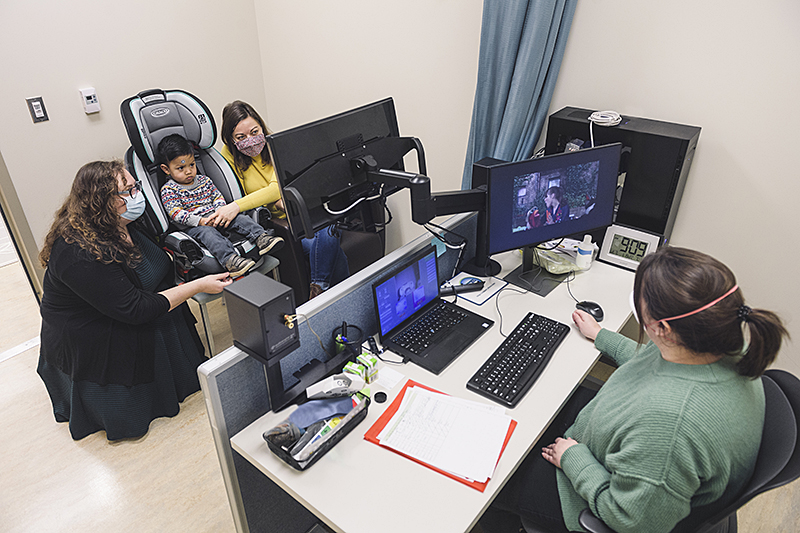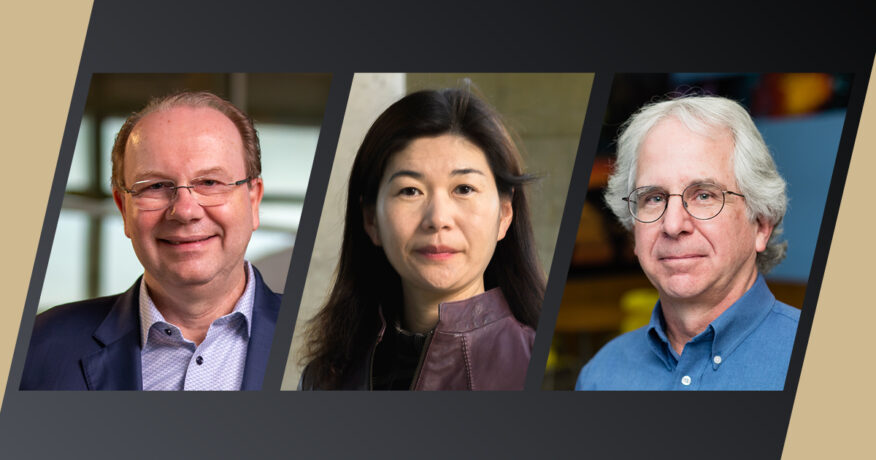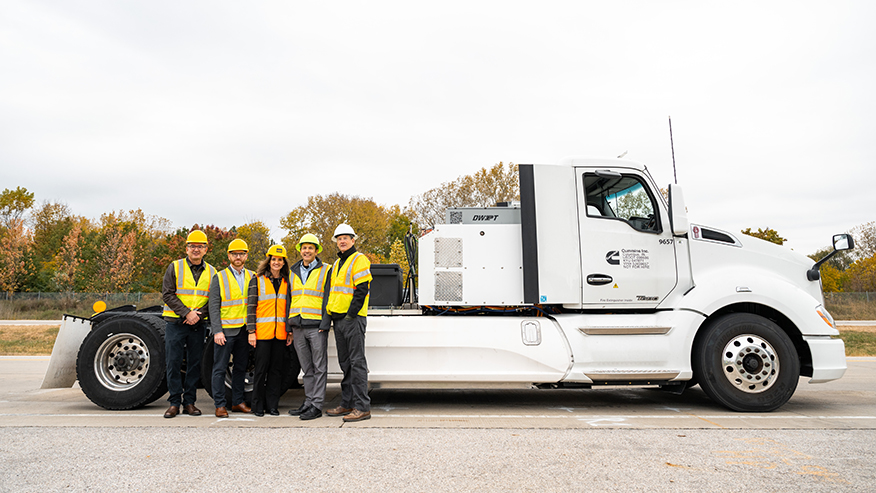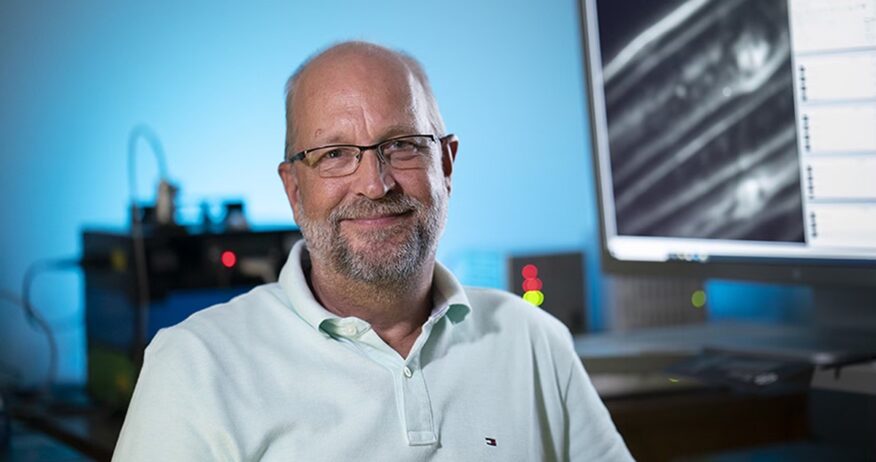What’s in a word? Identifying language disorders earlier can set children up for success
Expert focuses on skills that support children’s early word learning, language processing

Arielle Borovsky, associate professor in Speech, Language, and Hearing Sciences in Purdue’s College of Health and Human Sciences, works with Emily Newman and her son, Caleb. Borovsky studies language development in children – with an emphasis on the skills that support early word learning and language processing. Caleb has most recently participated in a study to understand some of those early indicators of language development over time. (Purdue University photo/Rebecca McElhoe)
WEST LAFAYETTE, Ind. —
A child’s first word can be a meaningful milestone for parents. But sometimes, children don’t have to say anything at all to teach us about how they develop their earliest vocabularies.
Arielle Borovsky, associate professor in Speech, Language, and Hearing Sciences in Purdue’s College of Health and Human Sciences, studies language development in children – with an emphasis on the skills that support early word learning and language processing.
“Our ability to communicate affects everything we do, both early and later on in life,” says Borovsky, who also heads the Language Learning and Meaning Acquisition Laboratory at Purdue. “We’re not just talking about children who are not as talkative as their friends. A difficulty in communicating our thoughts and understanding others can have lifelong consequences.”
Vocabulary development varies among children, making it difficult to have a one-size-fits-all approach to diagnosing language disorders. Through her research, Borovsky is working to identify early markers of language and reading disorders in young children. One common method Borovsky uses in her lab is eye-tracking technology, which uses a specialized camera to detect the timing and location of a child’s gaze in response to language.

“We use this technology to learn what children understand about their early words without requiring them to provide any kind of verbal or manual response,” Borovsky says. “Responding verbally can be difficult for young children, and particularly for children who do not yet say very many words. These studies give us a new way to measure more of the amazing abilities children have before they can say much to us.”
Borovsky is interested in developing ways to identify developmental language disorder, which affects 7% of school-age children. Children with developmental language disorder have difficulty understanding or using language but are not affected cognitively.
“These children are ready and eager to learn, and there is no simple explanation for what they’re experiencing,” Borovsky says. “It can be hard for children to cope with – and it can be especially hard as they get older.”
Eye-tracking technology can help Borovsky observe what children are understanding and predicting when it comes to their vocabularies, even if they’re not verbalizing it quite yet. This technology allows Borovsky’s lab to record and monitor a child’s gaze while they view objects.
“As we talk about something, we often look at it,” Borovsky says. “Babies do that, too. We’re trying to learn not only about whether they’re understanding words, but how quickly are they understanding them? Do they understand that there are words connected to that particular word?”
For example, if the child hears the word “dog,” Borovsky watches to see if and how quickly the child looks at a photo of a dog on the screen. Borovsky also explores how children understand patterns and can predict certain events – so in addition to hearing the word “dog,” the child will view related objects to see what they might be predicting.
“In an experiment, a child might see an image of a dog paired with another image,” she says. “Sometimes that other image is closely related to the dog – like cat. Other times, it’s an unrelated item like car. How children recognize the word “dog” in these two different conditions tells us about whether they understand that some words are connected – like dog and cat – and others are not. Understanding these connections is an important stepping stone in building vocabulary.”
In one of Borovsky’s recent studies, she found that how children recognize these connections between word meanings reflects connections in the words in that child’s vocabulary. Knowing a neighborhood of related words helped children between 18 to 24 months improve their ability to recognize a spoken word with their object. Borovsky then followed these children in the lab and found that their early vocabulary “structure” and ability to recognize word meanings predicted later language abilities when the same children turned 3. The work was published in Developmental Psychology. Borovsky is now conducting a larger study to try to understand these early language skills in greater detail and over a longer period of time in children’s development.
Emily Newman and her two children, Noah, 8, and Caleb, 2, have participated in studies with the Language Learning and Meaning Acquisition Laboratory over the last several years. Caleb has most recently participated in a study to understand some of those early indicators of language development over time.
Noah, who deals with stuttering, participated in both research and speech therapy at Purdue. “When it comes to child development, so many problems are best dealt with early,” Newman says. “The longer you wait to help a child who is struggling, the more they get frustrated and overwhelmed with the expectations that are put on them. The earlier there are indicators that a child may struggle on any level, the sooner they can get help and hopefully avoid some of those emotional barriers they might face.”
Borovsky has launched a new study, with the hopes of enrolling more than 150 families to understand the natural range of early language learning and at what age concerns about language development might start. Families in Lafayette and Indianapolis can contact Borovsky directly to enroll in the study.
The earlier language disorders can be identified, the earlier children can get the help they need. “If we can make those diagnoses sooner, we can get them ready for school before they start to struggle in a school setting,” Borovsky says. “We can help set children up for success before they set foot in a classroom.”
Borovsky says that in addition to finding those early markers of children who are at risk for language disorders, it’s also important to have a better understanding of what the normal trajectory is for language development in infants.
“What is it about language that takes children from being a screaming baby at birth to a child having complete conversations with us just a few years later? It’s an amazing time period, and there is a lot of learning taking place – it’s not something we can do as adults. Having a better idea of what’s going on in their minds will help us help other children both now and down the road.”
Purdue Speech, Language, and Hearing Sciences is a top-ranked department (No. 3 in Speech-Language Pathology and No. 9 in Audiology, 2021 U.S. News & World Report) with research and clinical efforts to mechanistically investigate and treat a variety of hearing, speaking, language and swallowing disorders. Its state-of-the-art research and clinical laboratories facilitate cutting-edge scientific discoveries and a committed engagement with the local community through top-quality clinical service delivery. The department supports the stellar education of its students through four preeminent degree programs. Visit https://www.purdue.edu/hhs/slhs/ to learn more.
About Purdue University
Purdue University is a top public research institution developing practical solutions to today’s toughest challenges. Ranked in each of the last five years as one of the 10 Most Innovative universities in the United States by U.S. News & World Report, Purdue delivers world-changing research and out-of-this-world discovery. Committed to hands-on and online, real-world learning, Purdue offers a transformative education to all. Committed to affordability and accessibility, Purdue has frozen tuition and most fees at 2012-13 levels, enabling more students than ever to graduate debt-free. See how Purdue never stops in the persistent pursuit of the next giant leap at https://stories.purdue.edu.
Writer/Media contact: Abbey Nickel, nickela@purdue.edu
Source: Arielle Borovsky, aborovsky@purdue.edu



